- Quick Read
- Deep Read ( 6 Min. )
Monitor Daily Podcast
- Follow us:
- Apple Podcasts
- Spotify
- RSS Feed
- Download
TODAY’S INTRO
Trump’s unusual move
Former President Donald Trump did something unusual for him on Monday: He attended the beginning of one of his own trials.
The civil case, brought by the New York state attorney general, accuses Mr. Trump of greatly exaggerating his net worth to get better terms on bank loans.
Unlike the criminal trials the former president will face next year, this trial does not bring the threat of a prison sentence. Rather, at stake here is money – possibly large sums.
On Monday, his lawyers argued that Mr. Trump’s actions cited in the suit constituted typical real estate practice.
“There is no crime. The crime is against me,” Mr. Trump told reporters outside the courtroom.
The judge overseeing the case, Arthur Engoron, has already ruled that Mr. Trump and his business organization committed fraud on a broad scale. Trump businesses claimed that the former president’s Trump Tower residence was 30,000 square feet, almost triple its actual size, according to Judge Engoron. They listed rent-stabilized apartments at market rates and inflated the price of Trump golf club memberships.
Reportedly, Mr. Trump’s lawyers did not request a jury trial, meaning the ruling is in Mr. Engoron’s hands. The trial beginning this week will set penalties. If the judge’s ruling withstands appeals, Mr. Trump could lose control over many of his signature New York properties, and he may have to pay a fine of upward of $250 million.
It’s unclear what political effect a ruling might have in today’s polarized landscape. But the trial represents a challenge to a core part of the former president’s identity: his brand as a successful real estate tycoon.
Share this article
Link copied.

Help fund Monitor journalism for $11/ month
Already a subscriber? Login

Monitor journalism changes lives because we open that too-small box that most people think they live in. We believe news can and should expand a sense of identity and possibility beyond narrow conventional expectations.
Our work isn't possible without your support.
Behind impasse in Congress: Rising deficits, record debt
There’s an element of political theater to the budget showdown that almost caused a government shutdown in the United States over the weekend. But behind the unfinished drama are difficult challenges of debt and deficits.

Congress bought itself more time with a weekend agreement to avoid a government shutdown, but now a 45-day clock is ticking to reach a deal on the federal budget – and both parties will need to be involved in reaching it.
Partisanship is so intense that expectations in Washington are low that Congress will solve much of anything before elections 13 months from now.
But the reality is that control of power is narrowly divided between both parties, and doing nothing is not an option. They’ll need to find a path to keep the U.S. government running in 2024. And time, math, and a record $33 trillion national debt dictate that, at some point, leaders in Washington will have to step up to the plate and make other difficult decisions.
Deadlines over tax cuts, Medicare, and Social Security face Congress over the next decade. Senators on both sides of the aisle have expressed an interest in creating a bipartisan commission to address the deficits and debt, and House Speaker Kevin McCarthy included the idea in one recent resolution aiming to keep the government funded.
“That’s an encouraging sign,” says Marc Goldwein, senior policy director for the Committee for a Responsible Federal Budget, a nonpartisan deficit-reduction group in Washington. “Is it enough to save Social Security and stop our debt from rising? No. ... But I think it’s a big first step.”
Behind impasse in Congress: Rising deficits, record debt

Congress bought itself more time with a weekend agreement to avoid a government shutdown, but now a 45-day clock is ticking to reach a deal on the federal budget – and both parties will need to be involved in reaching it.
Partisanship is so intense that expectations in Washington are low that Congress will solve much of anything before elections 13 months from now. The talks in coming weeks will focus on just discretionary spending, not entitlement programs, for one thing.
But the reality is that control of power is narrowly divided between both parties, and doing nothing is not an option. They’ll need to find a deal to keep the government running in 2024. And time, math, and a record $33 trillion national debt dictate that, at some point, leaders in Washington will have to step up to the plate and make other difficult decisions.
The problem, economists say, isn’t that deficits and debt are inherently bad things. Rather, it’s a question of sustainable financing and maintaining public confidence – and the latest trend lines in the United States aren’t good: As a share of the economy, the deficit in the just-finished fiscal year was larger than at any past time when the country did not face a recession or other major emergency like a war. National debt keeps rising even as the interest rates on that borrowing have also surged.
“Like it or not, people will have to stand up – and both sides, the tax side and the spending side, are going to have to give,” says Glenn Hubbard, economics professor at Columbia Business School and a former chair of the president’s Council of Economic Advisers. “I can’t imagine a politically viable solution that says it’s all about taxes or all about spending.”
Rising pressure over taxes, entitlements
Congress doesn’t have to reach a dramatic package of solutions all at once. Deadlines are coming, however.
Its most immediate deadline – Nov. 17 – is the most fungible. That’s when Congress is supposed to pass a dozen spending bills to keep government funded for the year. But legislators have kicked the can down the road before, as they did on Saturday, passing temporary resolutions to keep government funded at current levels. They can do so again.
“We’ve gotten into a cycle where we are budgeting by crisis,” says Shai Akabas, executive director of the economic policy program for the Bipartisan Policy Center, a Washington think tank. “And that doesn’t allow any oxygen for the bigger-picture budget issues that are really quite important.”

Other deadlines are far less forgiving. At the end of 2025, for example, the tax cuts passed early in the Trump administration expire. Congress will be forced to hash out a new tax package or most Americans will see their tax rates go up by 1 to 4 percentage points.
Another deadline is 2033. That’s when the Social Security trust fund reserves are expected to run out. If that happens, the nation’s older citizens – a potent voting bloc – will see their monthly Social Security payments cut by about a quarter. Retirees will still receive benefits because the system will fund those benefits from current contributions of working Americans. But as the population ages and the ratio of retirees to workers increases, the benefits will continue to dwindle.
Medicare is in an even worse situation. Medicare Part A, which covers hospitalization, is expected to see its trust fund exhausted by 2031.
Too big for one party to solve
So far, Congress has avoided making the changes needed to boost funding for these programs or to address federal deficits, which continue to balloon.
“These are very difficult votes,” says Howard Gleckman, a senior fellow at the Tax Policy Center, a Washington think tank. “You’re going to get people mad at you if you cut their spending programs or if you raise their taxes. And the only way to insulate yourself from some of that is to make it bipartisan – for everybody to kind of agree together that they’re going to make these cuts.”
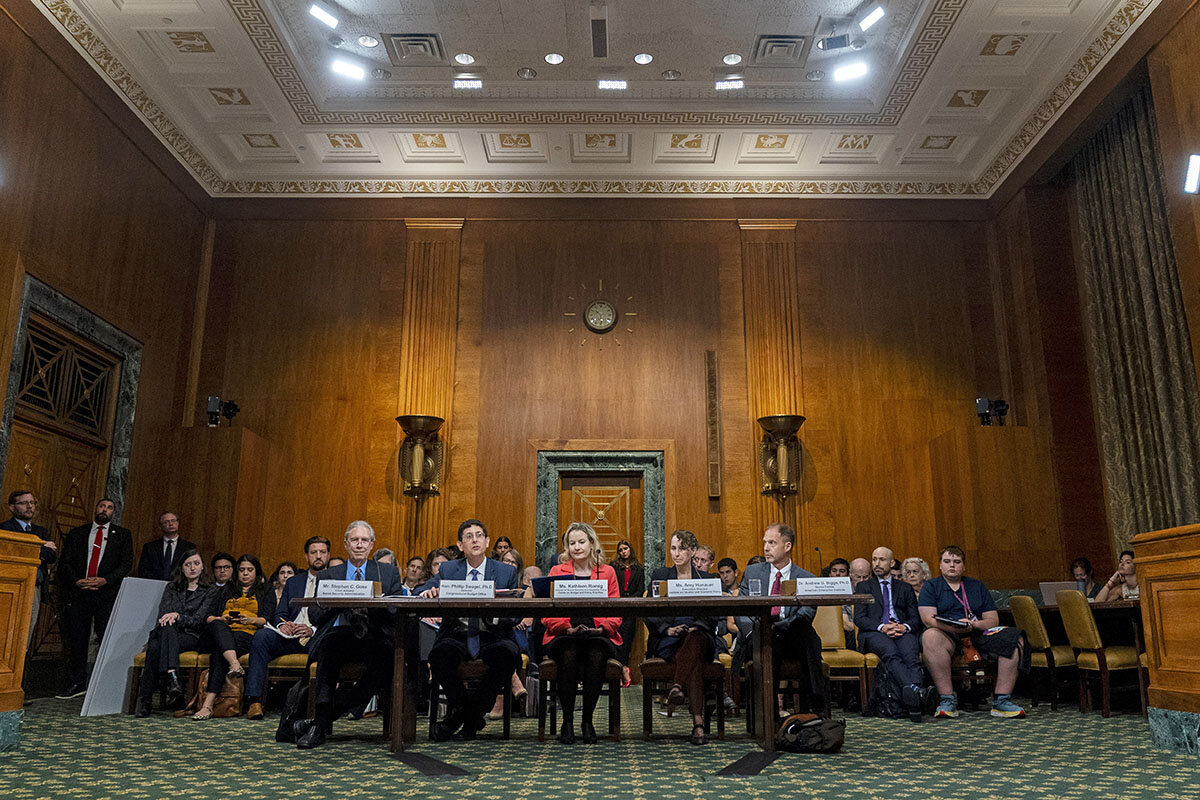
Looming over all of this is the federal debt. For decades, economists have been warning about its dangers. But nothing terrible has happened. The money spent on paying the interest on the debt has not appreciably crowded out funding for private business. Foreign confidence in the dollar has not eroded, although credit ratings are at risk. Like a ship of state drifting into ever deeper waters of red ink, the U.S. has not yet hit an iceberg.
In the meantime, the debt has continued to rise because of spiraling budget deficits. President Donald Trump pushed deficit spending to record highs, first with tax cuts, which reduced federal revenues, and then much more during the pandemic with two stimulus packages designed to keep the economy afloat. President Joe Biden followed with more pandemic relief plus big spending on Democratic priorities including infrastructure and green energy.
Servicing the debt gets costlier
In the past year, the nation’s slide into deep red ink has accelerated. To counter rising inflation – caused at least in part by the record federal spending, economists say – the Federal Reserve has had to dramatically increase interest rates. Those high interest rates, in turn, have made the federal debt more expensive to service. The Congressional Budget Office now estimates the U.S. will spend $10.5 trillion on interest over the next 10 years. “That’s completely nonproductive money,” says Mr. Gleckman of the Tax Policy Center. “I could think of a lot of things the government could do with $10 trillion.”
Congress’ inaction over the years in the face of such rising costs has created extreme frustration on the far right, enough so that the House Freedom Caucus has tried to force budget showdowns this year. First it threatened to hold up a debt limit increase earlier this year, which could have severely damaged the economy by defaulting on Treasury debt. Now come the talks on federal budget appropriations, which could shut down the government if a deal isn’t reached by the new deadline of Nov. 17.
Calls rising for a bipartisan commission
While condemning the conservatives’ intransigence and tactics, many conservative economists are also sounding the alarm over Congress’ inability to deal meaningfully with deficits and the debt. “Enough’s enough,” says Gordon Gray, vice president for economic policy at the American Action Forum. Under President Biden, “we got the American Rescue Plan and we’ve since gotten more and more and more” spending.
Amid the current chaos and conflict in Congress, some budget experts point to signs of progress, especially potential moves to create a federal budget commission that would address in a bipartisan way the twin problems of deficits and debt. Senators on both sides of the aisle have expressed an interest in creating one, and House Speaker Kevin McCarthy included the idea in an earlier resolution to keep the government funded. (The House resolution that eventually succeeded did not include it.)
“That’s an encouraging sign,” says Marc Goldwein, senior policy director at the Committee for a Responsible Federal Budget, a nonpartisan deficit-reduction group in Washington. “Is it enough to save Social Security and stop our debt from rising? No. ... But I think it’s a big first step.”

As Chechen scion beats prisoner, Russia is shocked
In theory, Russian law applies everywhere within Russia’s borders. But over and over, the Chechen republic proves exempt from those rules, no matter how blatant a violation might be.

- Quick Read
- Deep Read ( 4 Min. )
When Chechen leader Ramzan Kadyrov posted a video online last week that showed his teenage son brutally beating up a Russian prisoner, Mr. Kadyrov said he was “proud” of his son’s actions. But many Russians were shocked, and the Kremlin was visibly irritated.
The episode highlights the basic conundrum of the arrangement that ended a decadelong cycle of wars between Russia and the formerly separatist Caucasus republic. Russia’s military devastated and pacified Chechnya, and the Russian government expended vast subsidies to reconstruct Chechnya’s war-ravaged cities. But Moscow left Chechnya in the hands of a leader who had a free hand to run the republic as he wished.
The result is a maze of contradictions, a statelet where Russian law is openly flouted and the official ideology is at odds with the Russian Constitution.
Oleg Orlov, chairman of the now-banned Memorial human rights center, says the odd relationship of Chechnya to Russia is not an accident, but part of Russian President Vladimir Putin’s design for governing.
“At some point I thought Chechnya was a tiger that had escaped from the Kremlin’s control,” he says. “But then I realized that it’s part of Putin’s system of balances and counterbalances. Even if the situation with Chechnya is bad for Russia, it’s good for Putin.”
As Chechen scion beats prisoner, Russia is shocked

When Chechen leader Ramzan Kadyrov posted a video on his Telegram channel last week that showed his teenage son brutally beating up a Russian prisoner, Mr. Kadyrov said he was “proud” of his son’s actions.
But many Russians were shocked, and the Kremlin was visibly irritated.
The episode is just the latest of many in recent years to highlight the basic conundrum at the heart of the arrangement ending a decade-long cycle of wars between Russia and the formerly separatist Caucasus republic.
Russia’s military devastated and pacified Chechnya, and the Russian government expended vast subsidies to reconstruct Chechnya’s war-ravaged cities. But Moscow did little to reintegrate the republic with Russia’s constitutional order, and instead left Chechnya in the hands of a leader who swore fealty to Russia but otherwise had a free hand to run the republic as he wished.
The result is a maze of contradictions, a statelet where Russian law is openly flouted and the official ideology is at odds with the Russian constitution. Yet it is one of the most Kremlin-loyal regions in Russia, and has sent thousands of volunteers to fight alongside Russian troops in the war against Ukraine.
“The regime installed in Chechnya was intended to establish peace and insure Moscow’s control,” says Andrei Kolesnikov, a Carnegie expert who continues to live and work in Russia.
But very quickly it became more of a feudal system in which Mr. Kadyrov enjoys absolute personal power, Chechen clans are his vassals, and his rule is enforced by brutal methods, Mr. Kolesnikov adds. Mr. Kadyrov repays Russian President Vladimir Putin for Moscow’s lavish subsidies with total loyalty. “The tasks set by Putin were solved by such methods, and he was satisfied. Kadyrov demonstrates absolute loyalty, and that is why he is permitted more than the heads of other regions.”
Oleg Orlov, chairman of the now-banned Memorial human rights center, says the odd relationship of Chechnya to Russia is not an accident, but part of Mr. Putin’s design for governing his huge, fractious country.
“At some point I thought Chechnya was a tiger that had escaped from the Kremlin’s control,” he says. “But then I realized that it’s part of Putin’s system of balances and counter-balances. Even if the situation with Chechnya is bad for Russia, it’s good for Putin.”
But it comes at the price of constant embarrassment, as inner-Chechen reality and Mr. Kadyrov’s wayward behavior repeatedly underlines the difficult and disconnected nature of Chechnya’s place within the Russian Federation.
“Chechnya is a separate state”
After Mr. Kadyrov posted the video of his son beating an incarcerated man, Kremlin spokesman Dmitry Peskov opened his daily briefing with a shrug: “I will say from the start, I will not comment on the story about Kadyrov’s son,” he said. “I don’t want to.”
Mr. Orlov says the Kremlin faces a dilemma. “It’s not the first time Kadyrov has put the Kremlin in a stupid situation. They can neither support nor condemn him. Peskov’s reaction shows they are at a loss for what to do.”
Many other Russian politicians and thought leaders offered what was, for many, unusual expressions of outrage. “This is a challenge to Russia’s whole legal system. They have shown that they can commit crimes and nothing will happen to them,” said Eva Merkacheva, a member of Russia’s Presidential Human Rights Council.
The abused prisoner was a Russian man, Nikita Zhuravel, from Volgograd, a city far from Chechnya. Last May, Mr. Zhuravel was charged with “insulting the feelings of religious believers” by allegedly burning a Koran outside of a mosque at the behest of Ukrainian intelligence services, it was claimed.
The alleged crime was local, but Russia’s Investigative Committee used strained reasoning to transfer the incarcerated man to Chechnya for “further investigation.” How Mr. Kadyrov’s son happened to gain access to the prisoner, and given the opportunity to beat him, has not been explained.
“For Russian intellectuals it emphasizes that Chechnya is a separate state, outside the laws of Russia,” says Grigory Shvedov, editor of Caucasian Knot, an independent online news site that covers the Caucasian region. “Ordinary Russians usually don’t think about Chechnya, or care whether it recognizes Russian law. But this case draws attention, because it shows that any regular Russian person could be sent to Chechnya and end up a similar situation. ... This person, Zhuravel, might be innocent, just a victim, but he was just taken to Grozny and treated in such a way.”
Even many Chechens appear to have been shocked by the arbitrary violence depicted in the video, Mr. Kadyrov’s declared pride in his son’s actions, and the absolute impunity it suggests. Chechnya’s state TV channel posted a survey on its Telegram channel last week asking viewers how they react to the younger Kadyrov’s actions. The first wave of responses showed 84% took it negatively, and even after the results began to shift, 55% were still condemning it a full day later.
Despite such embarrassments, some analysts say the Chechnya model has been a success for the Kremlin, one that perhaps holds implications for the final outcome of the ongoing war in Ukraine. It took a long time to subdue Chechnya, the human costs were horrific, and the expense of rebuilding it exorbitant. Yet the long-term result is a territory under reliable control, with a pacified population and a loyal leader.
“The Chechnya model not only looks like a success from Moscow’s point of view,” says Mr. Shvedov. “It comes down to the question of price: Was it worth it? And it looks like the answer is yes, that’s a price [the Kremlin is] willing to pay.”

Military families need child care. Can Pentagon deliver?
New child care efforts aim to provide more options for military families, especially at a time of recruiting challenges. But the Pentagon has fallen short of past promises for care help.

- Quick Read
- Deep Read ( 6 Min. )
At a time when recruiting and retaining troops is becoming an urgent challenge for the Pentagon, more access to child care is increasingly seen as a must for military families. Defense officials, for their part, have promised that it’s a priority.
The Department of Defense is building more child care centers and increasing incentives for day care workers to fill chronic staffing shortages and help get parents off long waitlists.
There are other initiatives. The National Guard this year launched a pilot program to make child care free during weekend drills, and the Pentagon has announced a trial plan to fly in trusted people like grandparents to care for kids if the waitlist at a base facility exceeds one month.
Defense officials realize that they have overpromised and underdelivered in the past, military family advocates say. The challenge going forward, they add, is ensuring the Pentagon delivers on the services it advertises.
Roughly 40% of active duty service members have children. Of those kids, the largest percentage are age 5 and under.
“So you can imagine how important it is to have access to affordable, quality care,” says Patty Barron, the Pentagon’s point person overseeing military child care policy.
Military families need child care. Can Pentagon deliver?
At a time when recruiting and retaining troops is becoming an urgent challenge for the Pentagon, more access to child care is increasingly seen as a must for military families. Defense officials, for their part, have promised that it’s a priority.
The question is whether they can make it happen. Kayla Corbitt hopes so, but her experience with the system has not been without frustration. This came as a surprise. When she married her military husband after meeting him in graduate school, though she was a bit hazy on the array of services available to military families, her general impression was that they were “wonderful.”
The couple’s first postings belied that belief. When she got pregnant, Ms. Corbitt quit her job on base in Italy due to “such limited access” to child care. She worked hard to learn the ins and outs of applying for day care spots within the military system, however, and figured she would navigate it like a champ when her family was posted to the Washington, D.C., area in 2019.
She didn’t. Child care resources for military families in the region weren’t enough “to meet even half of the demand,” Ms. Corbitt says. She spent $7,000 in out-of-pocket expenses for waitlist fees and deposits that were never reimbursed. In the absence of care, Ms. Corbitt quit her new job. It was a year before she lined up another one with a place for her child.
The Pentagon has been busy building more child care centers and increasing incentives for day care workers to fill chronic staffing shortages and help get parents off long waitlists. There are other initiatives, too. The National Guard this year launched a pilot program to make child care free during weekend drills, and the Pentagon has announced a trial plan to fly in grandparents to care for kids if the waitlist at a base facility exceeds one month.
Defense officials realize that they have overpromised and underdelivered in the past, military family advocates say. The challenge going forward, they add, is ensuring the Pentagon delivers on the services it advertises.
Secretary of the Army Christine Wormuth has noted that as a mother herself, she understands “how hard” child care can be to find, “and how expensive it can be when you find it.”

Shortening lengthy waitlists
In the absence of immediate care options, many military families have little choice but to wait. The cost of child care in the United States nearly doubled between 1985 and 2011 alone, according to the Census Bureau. This puts most “high-quality civilian child care centers” out of reach for many service members, particularly the junior enlisted ranks, according to the Congressional Research Service.
Meanwhile, the U.S. military is having difficulty meeting recruitment goals. The Army missed its target by 15,000 people last year, and the Air Force, Marine Corps, and Navy are also struggling amid a decline in interest and eligibility.
Because the Pentagon doesn’t want to lose expensive-to-train talent, it operates the largest employer-sponsored child care program in the U.S., serving some 160,000 children and employing more than 23,600 workers at an annual cost of more than $1 billion.
It is subsidized, and waitlists can stretch on for months. The Pentagon is aiming to reduce these rolls by, among other things, building more than a dozen new child care centers nationwide with funds from the latest Pentagon spending bill. This construction takes, on average, three years to complete.
The physical buildings, however, are less a problem than chronic staffing shortages. Background checks alone can be “very lengthy,” taking upward of nine months to complete, says Caitlin Hamon, former deputy director of government relations at the National Military Families Association.
For this reason, Secretary of Defense Lloyd Austin last year announced that the Pentagon’s budget would include measures to recruit and retain child care workers by allowing them to enroll their own children in the centers at a 50% discount.
They also get top priority for spaces at the base facilities where they work, ahead even of single military parents and dual military couples.
Because military families move every three years or so, the Pentagon is also putting in place programs to reimburse service members for child care costs related to their frequent relocations.
If they can’t get child care within 30 days of arriving in a new home, for example, the military will give $500 to U.S.-based troops or $1,500 for those posted overseas to fly out a family member or another trusted caregiver.

Still, “asking a family member to give up what they’re doing and take care of your kids for free isn’t a great solution,” says Ms. Corbitt, who launched a nonprofit, Operation Child Care Project, to help, among other things, get information about navigating the system to military families. The organization also provides scholarships to help families pay waitlist or application fees during periods of transition.
“It’s frequently less than $1,500 that makes the difference between spouses being able to keep a job or finish school” and having child care, she adds.
Relying on “unpaid labor”
After coming to the U.S. from El Salvador as a young girl, Patty Barron watched her mother, a recent widow, struggle to find a place for her children during the long hours she worked to put food on the table.
“Child care was wherever she could find it, with whomever she could find it. Sometimes it was great, and sometimes it wasn’t so great,” Ms. Barron recalls. By the time she was 10 years old, Ms. Barron was caring for her younger brother and sister.
Today, as the deputy assistant secretary of defense for military community and family policy, she is the Pentagon’s point person overseeing military child care policy – and a working military spouse who for years had a personal perspective on day care.
“I followed my soldier for 30 years, and I can tell you that I don’t see a change in demand.” That’s in large part because, then as today, roughly 40% of active duty service members have children. Of those kids, the largest percentage are age 5 and under.
“So you can imagine how important it is to have access to affordable, quality care,” Ms. Barron notes.
In 1978, the Defense Department took formal responsibility for establishing child care centers for its troops. In the 1980s, the military began putting more money into them after an investigation found the majority of Pentagon day care centers didn’t meet safety codes or comply with “sanitation standards.”
Today, demand for these services far outstrips supply. “They’re great when you can access them,” says Ms. Corbitt, who estimates that in her experience fewer than 30% of military parents are able to land a place in on-base care.
In the meantime, she says, much like decades before, the military still “relies heavily on the unpaid labor of spouses” to pick up the slack.
Promising start to pilot programs
Within the halls of the Pentagon, officials say they are most encouraged by pilot programs to expand day care availability.
Previously the only centers the Pentagon deemed eligible for reimbursement were the roughly 10% of licensed child care programs in America that are nationally accredited.
“That’s a low number,” says Stacey Young, who as director of the Pentagon’s Office of Military Family Readiness Policy oversees child development programs.
“Accreditation isn’t cheap,” she adds. “But just because a program isn’t accredited doesn’t mean it’s not a quality program. ... We really needed to find a way to expand our capacity.”
The trick is to do it without sacrificing quality. In that quest, the Pentagon has begun “piggybacking” onto programs that states already have in place to measure and improve their centers – including providing quality ratings – and then “crosswalking it” with Pentagon standards, Ms. Young says.
If they align, military families are eligible for reimbursement. Currently the program, which ramped up post-pandemic, is in nine states and counting.
For Ms. Barron, the Pentagon bears a responsibility to ensure military families have good care wherever and whenever they need it. “What you don’t want is what my mom experienced,” she says.
Making sure military service members can focus at work, she argues, is a national security necessity, and spouses – many of whom work at child care centers – know that too, Ms. Barron adds.
“They bring an awful lot of love and attention to our kids, because they understand the lifestyle,” which – with frequent moves for children and parents often away on assignments – “is not easy.”
Editor's Note: This article has been updated to clarify the name of Operation Child Care Project.

Domestic violence survivors help victims – and abusers
Domestic violence survivors are at the front of the charge to break women’s silence and end cycles of violence across Japan. They say compassion is their superpower.

- Quick Read
- Deep Read ( 5 Min. )
-
By Takehiko Kambayashi Contributor
When Endo Yoshiko got married at 19, she was excited to be a homemaker. Instead, she spent most days gauging her abusive husband’s moods, “trying not to step on a land mine,” she says. Ms. Endo eventually escaped the marriage and found work as a domestic violence counselor.
“I understood victims’ fears, agony, and thirst for freedom,” she says.
In 2015, she founded Jikka, a nonprofit that operates more than a dozen safe rooms. It offers an alternative to Japan’s public shelter system, which was originally established under the 1956 Prostitution Prevention Law and has struggled to meet the needs of people experiencing domestic violence.
Jikka is part of a growing network of private shelters and civic groups – many helmed by women who’ve experienced domestic violence themselves – working to close that gap. At least 1 in 4 women in Japan experience spousal violence, according to government surveys, and few seek outside support. These survivor-run organizations aim to break the silence, help women gain financial independence, and, more recently, support perpetrators who want to end their behavior.
“Survivors don’t want future generations to go through what they had to go through,” says Kaino Tamie, an Ochanomizu University professor emeritus and expert on sexual violence prevention. “Many of them are eager to help.”
Domestic violence survivors help victims – and abusers

Yamazaki Kikuno’s husband would often get enraged over small things, but she blamed herself for every punch or kick. “I thought my communication skills were poor,” says Ms. Yamazaki, who lives on the northern Japanese island of Hokkaido.
In 1997, the violence reached a breaking point. Flying into a rage over the contents of a bento, or lunchbox, that she had made him, Ms. Yamazaki’s husband pushed her over and started wringing her neck in front of their children, as their daughter screamed for him to stop.
The incident prompted Ms. Yamazaki to flee to one of the few private shelters in Japan at the time: Onnano Space On in Sapporo, the island’s capital. The shelter’s then-leader Kondo Keiko fiercely condemned the violence, explaining that Ms. Yamazaki’s husband was a perpetrator of domestic violence.
“It was a huge eye-opening moment for me,” says Ms. Yamazaki, who now leads Onnano Space On.
Since that episode, Ms. Yamazaki, who also serves as a co-leader of All Japan Women’s Shelter Network, has learned the importance of survivors raising their voice. Indeed, she says many of the women running Japan’s growing network of shelters and civic groups that help victims – and, more recently, perpetrators – have experienced domestic violence themselves, though the network has never been formally surveyed.
“Survivors don’t want future generations to go through what they had to go through. Many of them are eager to help,” says Kaino Tamie, an Ochanomizu University professor emeritus and expert on sexual violence prevention.
The number of private shelters has gradually increased since Japan adopted its Act on Prevention of Spousal Violence and the Protection of Victims in 2001, yet many are cash-strapped. This is in part because the idea “that women are helping women is held in low regard” in Japan’s male-dominated society, says Ms. Kaino. She adds that the public should see these leaders as “resilient women” driven by compassion and hope for Japan’s future.
Breaking the silence
In Japan, most – though not all – people who experience domestic violence are women.
That’s not surprising, say experts, considering Japan ranked a record low of 125th out of 146 countries in the 2023 Global Gender Gap Index. This lack of gender equality means many women are unable to secure economic independence, making them especially vulnerable to abuse.

In fact, government surveys have found that at least 1 in 4 women experience spousal violence, though some experts believe the figure could be much higher. A survey presented in the Gender Equality Bureau’s 2023 White Paper also showed that nearly 42% of victims have never consulted with anyone about their abuse, reflecting a deep culture of silence.
Many still consider domestic violence to be a family matter, but sometimes it takes just one person to shatter that perception.
Yoshizaki Masao spent much of her young adult life as a homemaker in Tokyo, raising five children and enduring psychological abuse from her husband before she eventually broke free.
About two decades ago, she shared her experience with a magazine reporter, and her estranged husband, infuriated by the article, stormed into her workplace. Ms. Yoshizaki was not present that day, but the embarrassing incident made her believe she’d have no choice but to quit her job.
Then the messages started pouring in.
Colleagues flooded her inbox with encouraging notes, many confessing that they, too, had experienced domestic abuse. When she ventured back into the office, one co-worker turned up her sleeve to reveal a bluish bruise.
“I felt truly saved by their compassion,” says Ms. Yoshizaki.
In 2006, she partnered with several colleagues to form A Plus, a group that assists victims and offers domestic violence prevention programs.
Power of compassion
Endo Yoshiko got married at age 19 to a man who ended up being abusive.
“I wanted to be a homemaker,” she recalls with a playful smile. “But he was so cantankerous I was always gauging his moods, trying not to step on a land mine.”
After leaving her husband, she found work as a domestic violence counselor for the local government. She took to the role quickly. “I understood victims’ fears, agony, and thirst for freedom because I also went through these,” says Ms. Endo, a twice-divorced mother of three.
In 2015, she established the nonprofit Jikka (meaning “parents’ home”) in Kunitachi, Japan, which offers consultations on poverty and domestic violence and runs more than a dozen safe rooms, offering an alternative to Japan’s public shelter system.
The public system – which consists of a temporary shelter and consultation center in every prefecture – was established under the 1956 Prostitution Prevention Law to rehabilitate girls at risk of prostitution. The law was later expanded to include people experiencing domestic violence, but advocates say the system has never met this population’s needs. There are few services focused on helping women become financially independent, and in many prefectures, lingering associations with prostitution also impact care.

When Hoshino Airi fled from her domestic violence situation in 2017, she was surprised by the restrictive policies in place at Japan’s public shelters. The use of mobile phones was banned, she says, and survivors weren’t allowed to go to work.
In 2020, she launched DV Countermeasures Center in Yokohama, which promotes an approach with fewer restrictions, centered on those seeking help. The center supports single mothers in addition to women and children experiencing abuse.
Like Ms. Yamazaki, Ms. Hoshino had blamed herself for the abusive relationship, but that’s changed.
“I’ve decided to live by valuing myself,” says the certified psychology counselor and volunteer probation officer. “Otherwise, I would not be able to value my children in the truest sense. ... Victims need to build their self-esteem. So do batterers.”
Help for abusers?
Under the current legal system, Ms. Endo explains, “batterers are allowed to go unchecked” while the onus is on victims to seek out support. “The country has to educate batterers,” she says.
Yamaguchi Noriko is trying to do just that. Inspired by programs overseas, she founded the Tokyo-based nonprofit Aware in 2002, where those concerned about their own violent behaviors can sign up for a year of weekly group meetings.
She says that Japan is still a “backward country when it comes to countermeasures against batterers,” but since the launch of Aware, options have grown. Ms. Yamaguchi knows of more than 15 organizations that have started offering programs to help perpetrators end their behavior.
One participant, who declined to give his name, says he’s been attending “batterers’ meetings” for years and will continue until his wife allows him to stop.
At work, he was thrust into a tough, competitive world, he recalls, and then took his pent-up stress out on his family. His wife eventually gave him an ultimatum: Attend a program, or get a divorce.
“I thought of her as a possession, which I did not want to lose. So I decided to join,” he says. “Had I received a [domestic violence] prevention program regularly in youth, I would be totally different.”
Ms. Yoshizaki, the A Plus founder, says that’s a sentiment shared by every victim and perpetrator she meets.

After Beirut blast, community revives historic photo studio
If the cataclysmic 2020 explosion in Beirut’s port symbolized government neglect, the community’s rebirth has been a story of cooperation and generosity. One beneficiary: a tiny photo studio with its precious images of a bygone era.
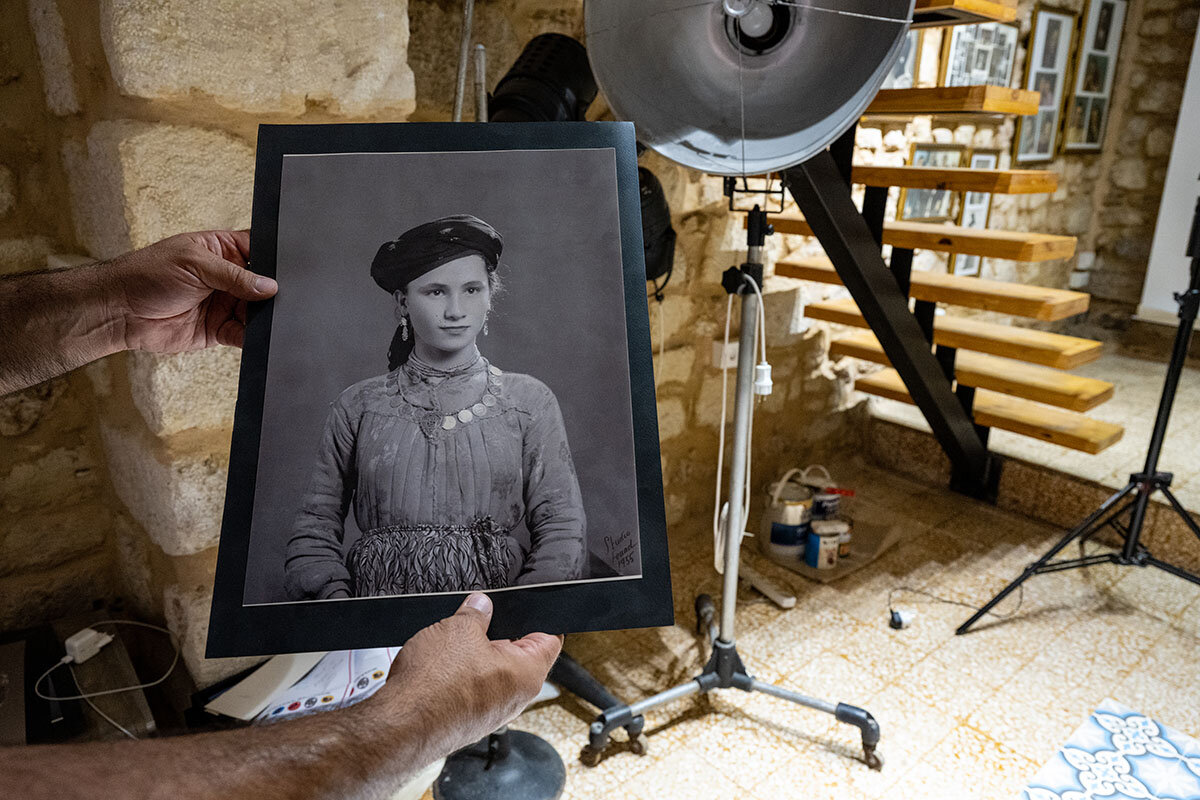
- Quick Read
- Deep Read ( 5 Min. )
The old photo studio’s trove of black-and-white negatives from the 1950s, wrapped carefully in paper and labeled in Arabic, is remarkable not only because of the bygone era it portrays but also because it survived the August 2020 blast at the nearby Port of Beirut.
That explosion left 300,000 people homeless, did $15 billion worth of damage, and turned Studio Fouad and many businesses on its street into piles of rubble.
Bitterness over government neglect that is blamed for the blast and continues today is evident in graffiti that blankets walls and traffic barriers nearby. But Studio Fouad and its neighborhood have experienced an extraordinary rebirth, thanks to the generous support of fellow Lebanese determined to rebuild, among them a supermarket chain, several nongovernmental organizations, and even foreign donors.
Today photographer Bandali Gharabi displays the studio’s precious archives in the same hole-in-the-wall location where his father opened the business in 1955. And he expresses deep gratitude for the outpouring of help that rescued the studio – the oldest in Lebanon – when his solo attempts could not.
“We were very surprised,” says Mr. Gharabi of the scale of that revitalizing aid. “We were dead, and they made us alive again.”
After Beirut blast, community revives historic photo studio
Lebanese photographer Bandali Gharabi takes hold of the round, old-style, archive film canister – its thick cardboard darkened by dust and the passing of decades – as carefully as if he were holding an ancient clay jar of Dead Sea Scrolls.
As he pries the lid off, revealing a trove of black-and-white negatives from the 1950s, rolled and wrapped carefully in paper and labeled in Arabic, Mr. Gharabi is opening a historical time capsule.
The images are remarkable not only because of what they portray but also because they survived the epic August 2020 blast at the nearby Port of Beirut. That accidental ignition of a stockpile of ammonium nitrate – the second-largest nonnuclear explosion ever recorded – left more than 200 people dead and 300,000 homeless, and did $15 billion worth of damage.
Amid the rubble was Mr. Gharabi’s photo studio, along with many of the businesses on this street in Beirut’s upmarket Gemmayzeh district.
Yet miraculously preserved between two walls of the former darkroom were the hundreds of thousands of archived images, taken and meticulously cared for by Mr. Gharabi’s father, Adib (who went by the nickname Fouad), ever since he opened Studio Fouad in 1955 and turned it into a Beirut institution.
Those archives – countless boxes and round canisters, rich with negatives that record weddings, portraits of school classes, and all manner of Lebanese lives from a bygone era – are all that remained from the blast that wrecked every camera in the shop, and for a time ruined Mr. Gharabi’s life.
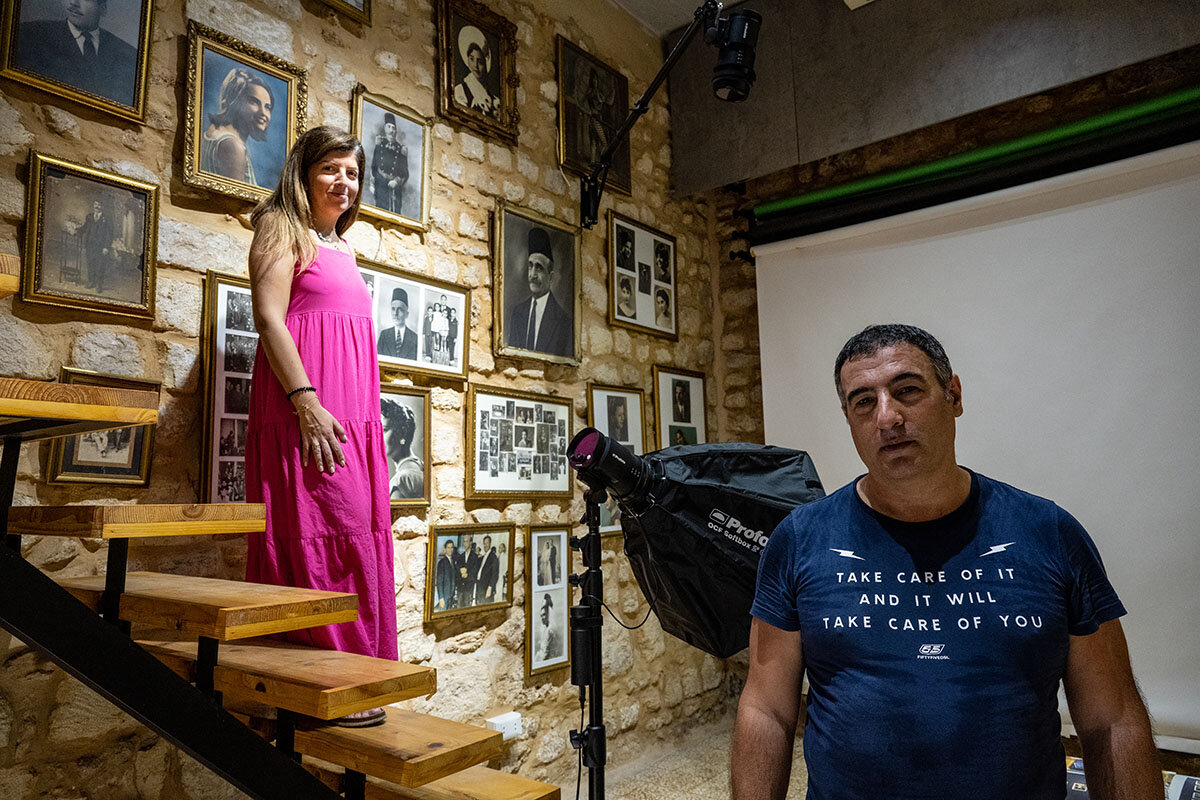
Deep gratitude
He displays the precious archives today in a revamped studio, in the same hole-in-the-wall location his father first founded. And he expresses deep gratitude for the outpouring of help from local rebuilding organizations and the community effort that rescued the photo studio – the oldest in Lebanon – when his solo attempts could not.
“We were very surprised: We were dead, and they made us alive again,” says Mr. Gharabi of the scale of that revitalizing aid. “Without that support, we would be closed.”
“For us, it was life – how can we continue?” says Mr. Gharabi’s wife and partner in the studio, Roula Gharabi. “How could we work? How could we eat?”
Those seemed like distant prospects in the immediate aftermath of the mid-2020 explosion. For many Lebanese it was the final sign of government collapse, incompetence, and corruption, after nearly a year of nationwide protests calling for reform brought little tangible change.
Levels of popular anger are still manifest in graffiti that blankets walls and concrete traffic barriers around the port. Alongside pictures that memorialize the dead, for example, are the words, “My government did this,” and “How? Why? Until when?”
One reminder beside a long mural of a stricken, sleeping child with a broken lighthouse and wrecked ship, reads, “We never forget. We never forgive. We never negotiate. We never shake hands.”
By chance, Mr. Gharabi was not in the studio at the time of the blast on Aug. 4, 2020 – he closed early that day – or he certainly would not have survived, he says. But he was there right away to stand guard over the rubble – and the archives. Thieves started to arrive in the area within 30 minutes to loot what they could.
That night, recalls Mr. Gharabi, an entire safe full of cash was stolen from the restaurant across the street, by uniformed burglars who claimed that they were “security” sent by the owner. In one case, a wallet was cut from the trousers of a dentist killed in the blast.

From heartbreak to rebirth
All day and all night for three days, Mr. Gharabi and other shop owners mounted a neighborhood watch and slept on the street. He shows pictures on his mobile phone of the wreckage, and what was for him the most heartbreaking moment: his 70-year-old father gingerly stepping through the rubble with his cane.
“He saw his whole neighborhood destroyed,” says Mr. Gharabi, pausing to again absorb the import of it all, for both his work and his father’s legacy. “He passed through the [1975-1990] civil war. He passed by so much, and then this.”
But before he passed away 10 months ago, Mr. Gharabi’s father would also be able to witness an extraordinary rebirth, of both the studio and the neighborhood, thanks to the generous support of fellow Lebanese determined to rebuild, despite continued government inaction and lack of support.
On the stone walls today are black and white photographs printed from those archives, including some that Mr. Gharabi’s father had colored by hand himself many years earlier.
But every aspect of the studio tells a different story of generosity, and the Gharabis can’t hide the tone of grateful shock in their voices, as they tick off every gift from fellow citizens, at home and abroad.
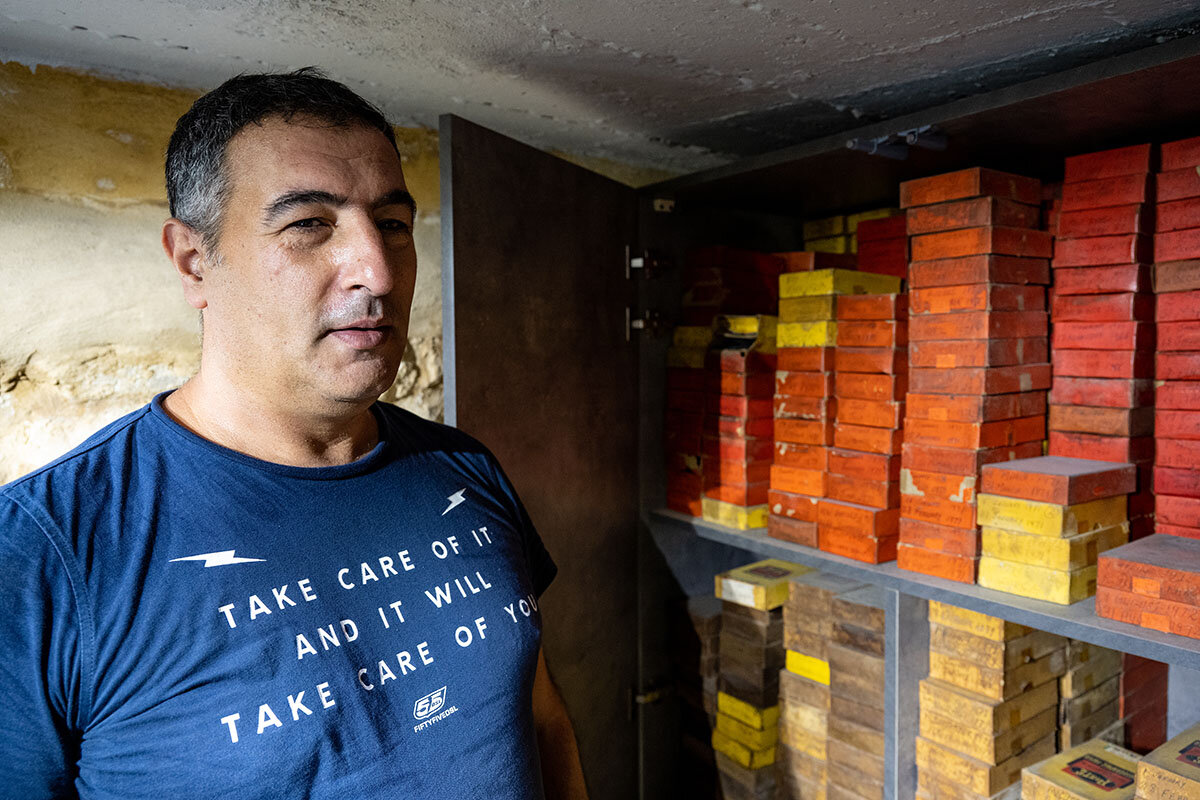
The Spinneys supermarket chain helped pay for the stairs, the glass, the second-floor office, and the shelves, for example. The Lions Club of Australia donated funds that paid for the cabinets that now house the archives. A nongovernmental organization named Live Love Beirut restored the floor on the second level. A brother’s GoFundMe campaign in Switzerland paid for the stones for the walls, and to fix the electricity.
The charity Together LiBeirut helped rebuild the studio website, print business cards, and pay for three months of advertising on Instagram.
And the cameras, too
And most critically, after months of having to turn down work due to lack of cameras, replacements were provided by a Lebanese civil society and environmental NGO called Al Mada.
Studio Fouad has been back in business since New Year’s 2022, in a line of shops freshly reclaimed from the ruins left by the port explosion. On shelves are some of the original cameras used by the family, and pride of place in the shop window is a sizeable 1920s-era, wooden large-format camera on a wood frame – a camera used to great effect since 1950 by Mr. Gharabi’s father.
Among the official portraits in the archives are also images of a community that once lived near the Beirut port more than half a century ago, when it was a small backwater. Before the blast, exhibitions of historic images from the archives were held in France, Germany, and Lebanon.
Preparations are underway now for a book and a new exhibition.
“This place is full of history,” says Mrs. Gharabi. “Some people come by and just say, ‘Can I come in? I feel nostalgic.’”
Other headline stories we’re watching
(Get live updates throughout the day.)The Monitor's View
Rule of law in an Asian hot spot
- Quick Read
- Deep Read ( 2 Min. )
-
By the Monitor's Editorial Board
In one of the world’s potential hot spots for armed conflict – the South China Sea – the Philippines has been a leader in trying to bring rule of law to waters where six nations make rival claims. In 2016, it won a ruling from a United Nations tribunal that China’s sweeping claims over most of the sea – notably in Philippine maritime territory – are invalid. Now Manila is weighing another court suit.
This one would allege that Chinese ships have pulverized coral reefs – again in the Philippines’ maritime zone – and used the material to build artificial islands to station more Chinese forces.
A new court case might help cool off rising tensions. Earlier this year, Chinese forces used military-grade lasers and water cannons against Philippine ships and sailors. Last month, Philippine special forces cut a rope tethering a floating barrier at a Chinese-controlled shoal.
If Beijing again loses a case in court, it might suffer further reputational damage. The previous ruling, says Philippine Foreign Affairs Secretary Enrique Manalo, remains “an inspiration for how matters should be considered – through reason and right – by states facing similarly challenging circumstances.”
Rule of law in an Asian hot spot

In one of the world’s potential hot spots for armed conflict – the South China Sea – the Philippines has been a leader in trying to bring rule of law to waters where six nations make rival claims. In 2016, it won a ruling from a United Nations tribunal that China’s sweeping claims over most of the sea – notably in Philippine maritime territory – are invalid. Now Manila is weighing another court suit.
This one would allege that Chinese ships have pulverized coral reefs – again in the Philippines’ maritime zone – and used the material to build artificial islands to station more Chinese forces. “We shall evaluate the merits of each and every legal option, including the possible filing of a new complaint against China before an international tribunal,” Solicitor General Menardo Guevarra told The Philippine Star last month.
A new court case, this one focused on marine destruction, might actually help cool off rising tensions. Earlier this year, Chinese forces used military-grade lasers and water cannons against Philippine ships and sailors. Last month, Philippine President Ferdinand Marcos ordered special forces to cut a rope tethering a floating barrier at the Chinese-controlled Scarborough Shoal. In August, the United States reaffirmed that it would live up to a 1951 mutual defense treaty and defend the Philippines if any of the country’s public vessels were attacked.
If Beijing again loses a case in court, it might suffer further reputational damage. It has promoted its own version of a rules-based international order and has been instilling stricter legality at home over the past decade. But its actions in the South China Sea undermine “efforts to cast itself as a source of peace and stability in the region,” writes China expert Carla Freeman at the U.S. Institute of Peace.
China has so far ignored the 2016 court ruling as well as hundreds of diplomatic protests by the Philippines over the years. Will a new court case make any difference? The previous ruling, says Philippine Foreign Affairs Secretary Enrique Manalo, remains “an inspiration for how matters should be considered – through reason and right – by states facing similarly challenging circumstances.” Outgunned by China off its shores, the Philippines is showing leadership in how rule of law can prevail in a watery trouble spot.

A Christian Science Perspective
Each weekday, the Monitor includes one clearly labeled religious article offering spiritual insight on contemporary issues, including the news. The publication – in its various forms – is produced for anyone who cares about the progress of the human endeavor around the world and seeks news reported with compassion, intelligence, and an essentially constructive lens. For many, that caring has religious roots. For many, it does not. The Monitor has always embraced both audiences. The Monitor is owned by a church – The First Church of Christ, Scientist, in Boston – whose founder was concerned with both the state of the world and the quality of available news.
Ready to handle Goliaths
- Quick Read
- Read or Listen ( 3 Min. )
-
By Curtis Wahlberg
As we nurture an awareness of God’s goodness and supremacy, we’re better equipped to address figurative Goliaths in life.
Ready to handle Goliaths
The Bible says that David, a shepherd who eventually became king of Israel, loved God, praying, and playing praises to God on the harp. And when necessary, he was ready to fight off both a bear and a lion that came after the sheep in his care. As a servant on the sidelines of a battle, David even volunteered to go toe to toe with the mighty Goliath, who had come forward to fight a representative of the Israelites, and he took him down with his slingshot.
Thinking of David’s story as a metaphor that applies to us, what might it mean today to bring down Goliaths?
Through my study and practice of Christian Science, I’ve increasingly come to think of our Goliaths not so much as specific people or even situations, but as harmful modes of thought. For instance, fears and oppressive attitudes – mental burdens that negatively impact our lives and leave us unprepared for addressing needs.
I’ve also found that an understanding of God enables us to tackle these mental Goliaths and then see progress on all fronts.
God, Spirit, divine Love, is the wonderful and good origin of what we truly are – not mortals susceptible to harm or limitation, but God’s spiritual expressions, reflecting qualities such as intelligence, purpose, and love. It’s these kinds of good qualities, which come from God, that define us – and so troublesome mental Goliaths are not a permanent, true part of us.
With something of this understanding, we go forward with more awareness of God’s all-defining, entirely good presence – an awareness that dissolves fears, troubles, or evils in thought. As our consciousness is increasingly cleared of these Goliaths, we find ourselves more equipped to deal with and overcome troubling conditions. The textbook of Christian Science explains, “Casting out evil and fear enables truth to outweigh error” (Mary Baker Eddy, “Science and Health with Key to the Scriptures,” p. 392).
One time my wife was faced with a daunting problem at work. Needing an answer, she turned to prayer, with a desire to really know and feel how God is the infinite source of intelligence and energy and life. In light of this truth, we are defined not by fears and limiting thoughts, but by the goodness of God that’s expressed in His spiritual offspring.
As she prayed, my wife had an unexpected idea that brought resolution to the work problem by the end of the day.
On her way home, she decided to stop by the supermarket. There, she overheard arguing and noticed shoppers scurrying away from a particular aisle, where she saw two women threatening each other.
Inspired by her experience at work earlier that day, my wife felt a spiritual strength that stemmed from an awareness of God as ever present, and of everyone’s real identity as reflecting God’s goodness. And it came to her, in this case, to step between the two women. Taking one gently by the arms, she said, “You don’t need to act this way.” The women seemed incredulous, but my wife calmly said it again. The impersonal Goliath of hostility dissolved and the women went on their way peacefully.
There’s value in being “prayed up” – consistently nurturing an awareness of God that helps us address mental Goliaths. I’ve found this is more effective than simply hoping answers will come along when problems arise. It brings spiritual strength and inspiration that lead to good resolutions and better lives.
God is the infinite Soul, our real Mind. We innately express God’s qualities of intelligence, purpose, and love – and affirming this in prayer enables us to experience God’s goodness more tangibly. Inharmony of any kind is not part of the consciousness and life that God has intended and maintains for each of us.
So, we can find some courage in these truths – courage to support the atmosphere of thought that brings down and even prevents Goliaths. The Bible encourages us to feel ready and equipped to live and share more of the divine good: “Sanctify the Lord God in your hearts: and be ready always to give an answer to every man that asketh you a reason of the hope that is in you” (I Peter 3:15).
Through prayerful discovery of God’s supreme goodness, we find and share hope and strength that leave no room for scary Goliaths. And in this way we can all play some part in moving toward a better world.

Viewfinder
Tools of learning
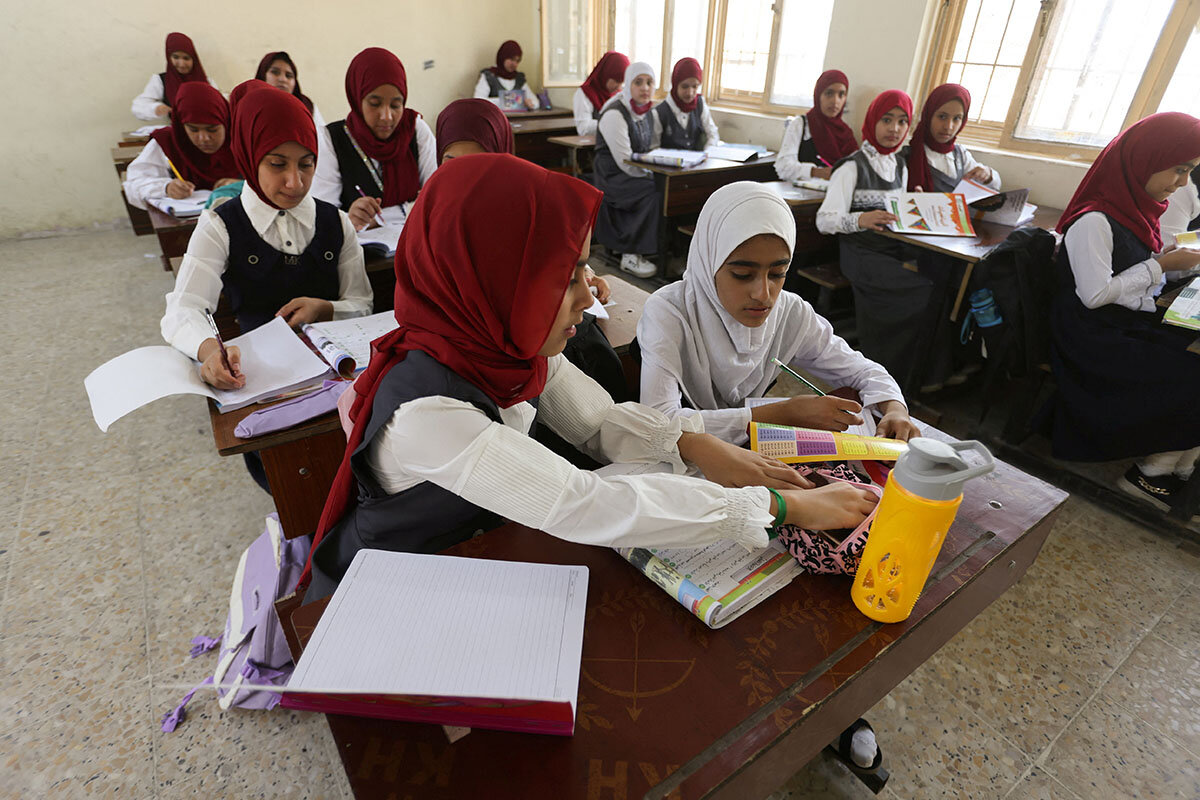
A look ahead
Thank you for spending time with the Monitor today. Tomorrow, we look at the crisis in Sudan amid conflict between two military factions. As atrocities mount, humanitarian workers wonder why the harrowing stories aren’t moving the world like similar reports from Darfur did 20 years ago.




